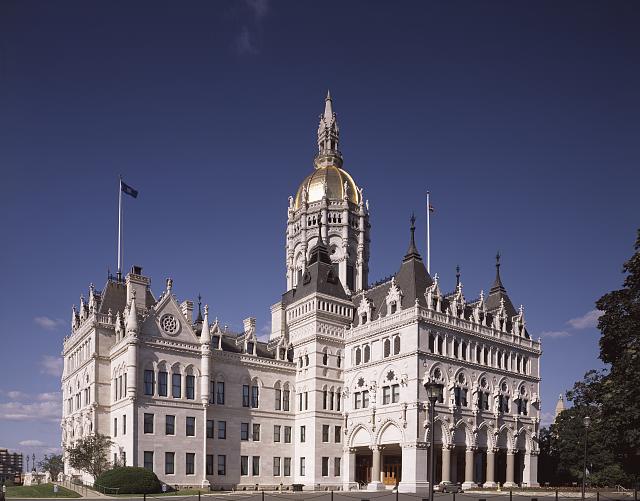Return to Introduction & Lessons at a Glance

Connecticut Capitol, Hartford. Photo: Carol M. Highsmith. Library of Congress
Introduction
The Connecticut State Capitol building is among the most beautiful in the country. Made of local stone and capped with a majestic gold dome, the building exudes stability, power, and pride. Within the building are sculptures celebrating many of Connecticut’s stories and heroes. In this lesson students will learn about the design of Connecticut’s capitol building, why it is designed the way it is, and apply the principles to their own classroom entrance.
Lesson Objective
After studying the architecture of the Connecticut state capitol building students will be able to apply architectural concepts that communicate civic messages to the design of an entrance to their classroom.
Grade Level
3 - 6
Introductory Discussion Questions
Begin with an in-class conversation about government and laws in general. This lesson works well have students have read Where I Live: Connecticut, pages 26 – 29. Discuss where the activities of government take place. Here are some questions to help guide the discussion.
Q. Who makes the laws?
A: The federal government, state government, and your town government
Q. Where is the national capitol where the President and the Congress work?
A. Washington, D.C.
Q. Where is the capital for the State of Connecticut?
A. Hartford
Q. What type of building do you need for the state capitol? What does it have to have?
A. offices, large meeting rooms, hallways, and conference rooms
Q. What is the difference between a public building and a private building?
A. A public building does not belong to one person. Public buildings are open to people (the public) and funded by public money (taxes). All types of governmental offices are considered public buildings. Examples include town halls, post offices, courthouses, and jails. Private buildings are owned by individuals and businesses. Examples include the house you live in, stores, and churches.
Lesson Activity & Procedure
1. After completing the discussion questions, students first need to understand the concept of federalism. To do this, ask the students:
- Are the rules the same in every classroom in the school?
- Do some teachers have more rules than others? (classroom rules)
- Are there some rules that need to be honored in every classroom? (school rules, safety rules)
- Can you think of any rules that apply to all the schools? (district rules)
2. Explain that the concept of federalism is that, just like we have different levels of rules in our district, schools, and classroom, we also have national laws, state laws, and town laws. States share power with the national government.
3. Ask the students to draw an illustrated dictionary entry of the word Federalism using the instructions below.
ILLUSTRATED DICTIONARY ENTRY
a. Write a definition of federalism in your own words
b. Include a synonym and antonym
c. Draw an illustration for each term
4. Ask the students where our town laws are made, where our state laws are made, and where our national laws are made.
5. Now we are going to investigate our state capitol by reading this students resource:
Learning Through Places: The State Capital
Have your students look closely at the first image and answer the questions provided in a classroom discussion. Some prompts are provided below.
- What do you see in the photograph?
- Does this building look important? Why?
- Is the building large or small?
- Does it look old or new?
- Is it simple and plain or elaborate and fancy?
- What is the tallest feature of the building?
- Can you see any statues?
- Does it look like people take care of this building?
6. As the students are learning about our capitol building have them answer the prompt:
List 4 types of people or things that are celebrated in the capitol building.
7. Have the students share their answers and record them so that the class gets a sense of the types of things that the State of Connecticut is proud of.
8. Now we are going to design a class entrance to our classroom. We want our entrance to show our values and points of pride. Before we design the entrance we have to identify the aspects we want to communicate and then brainstorm ways we can show them. Use the bottom of the Planning Sheet and
Make an Entrance Activity
9. Exit slip: The architecture or design of a building can show important things by _____________________, ______________________, and ________________________.
Word Wall
public, symbol, capital, capitol, memorial, monument
State Standards Alignment
HISTORY
Change, Continuity, and Context
HIST 3.1-3:10
Compelling Questions:
· What symbols represent our town and state?
· Why were specific individuals in your community honored through monuments or memorials, and how did they affect the history of your town, state, and country?
· How has our town changed and/or stayed the same over time?